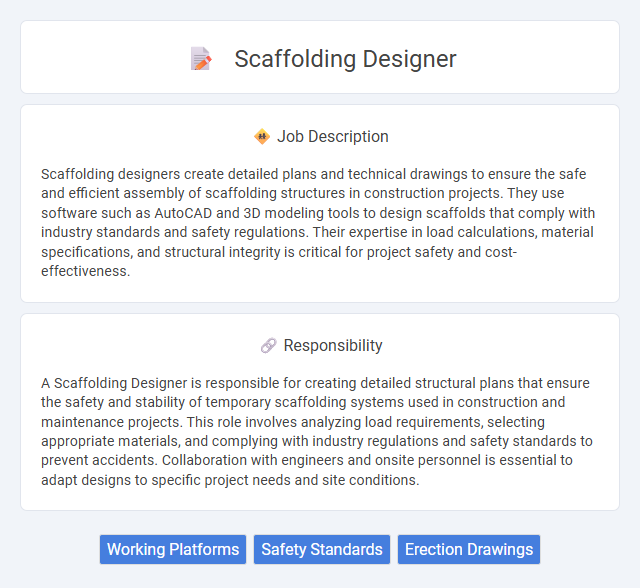
Scaffolding designers create detailed plans and technical drawings to ensure the safe and efficient assembly of scaffolding structures in construction projects. They use software such as AutoCAD and 3D modeling tools to design scaffolds that comply with industry standards and safety regulations. Their expertise in load calculations, material specifications, and structural integrity is critical for project safety and cost-effectiveness.
Individuals with strong spatial awareness, attention to detail, and problem-solving skills are likely suitable for a scaffolding designer role. Those who can handle high-pressure situations and work collaboratively within construction teams may find this job fitting. Candidates with a background in engineering or architecture might have a higher probability of success in this profession.
Qualification
A Scaffolding Designer must possess a degree or diploma in civil engineering, structural engineering, or a related discipline, combined with specialized training in scaffolding systems and safety standards. Expertise in computer-aided design (CAD) software and knowledge of relevant industry codes, such as OSHA and EN standards, are essential for creating accurate and compliant scaffolding plans. Practical experience in site assessment, load calculation, and risk analysis ensures the designer can produce safe, efficient, and cost-effective scaffolding solutions.
Responsibility
A Scaffolding Designer is responsible for creating detailed structural plans that ensure the safety and stability of temporary scaffolding systems used in construction and maintenance projects. This role involves analyzing load requirements, selecting appropriate materials, and complying with industry regulations and safety standards to prevent accidents. Collaboration with engineers and onsite personnel is essential to adapt designs to specific project needs and site conditions.
Benefit
A scaffolding designer role likely offers significant benefits such as enhanced safety through precise structural planning and adherence to regulations. Candidates in this position may experience career growth opportunities due to their specialized skills in engineering and construction. The job also probably provides job stability given the continuous demand for safe, efficient scaffolding in various industries.
Challenge
Working as a scaffolding designer likely involves complex challenges related to ensuring structural safety while optimizing material use. The role probably requires navigating tight project deadlines, adapting designs to varied site conditions, and complying with evolving industry standards. Managing these demands effectively may lead to innovative solutions that enhance both efficiency and safety in construction projects.
Career Advancement
Scaffolding designers play a critical role in ensuring safe and efficient construction projects through detailed planning and structural analysis. Career advancement opportunities include moving into senior design roles, project management, or specialized engineering consultancy, leveraging expertise in CAD software and industry regulations. Continuous professional development and certifications in structural engineering or project management significantly enhance prospects for leadership positions within engineering firms or construction companies.
Key Terms
Working Platforms
Scaffolding designers specialize in creating safe and efficient working platforms tailored for construction, maintenance, and industrial projects, ensuring compliance with OSHA and ANSI standards. They conduct site assessments and structural load calculations to optimize platform stability and worker safety. Expertise in material selection and modular system integration enhances the durability and adaptability of scaffolding solutions across various environments.
Safety Standards
Scaffolding designers ensure structural integrity by adhering to rigorous safety standards such as OSHA and ANSI regulations, minimizing risks of collapse and worker injury. They meticulously calculate load capacities, material strengths, and environmental factors to create safe, compliant scaffolding systems. Their expertise prevents accidents on construction sites, protecting both workers and project timelines.
Erection Drawings
Scaffolding designers specialize in creating detailed erection drawings that outline the precise assembly of scaffold structures, ensuring compliance with safety standards and project specifications. These drawings incorporate load calculations, material specifications, and site conditions to optimize stability and accessibility during construction or maintenance operations. Expertise in CAD software and structural engineering principles is essential for producing accurate, clear erection drawings that facilitate efficient on-site implementation.
 kuljobs.com
kuljobs.com